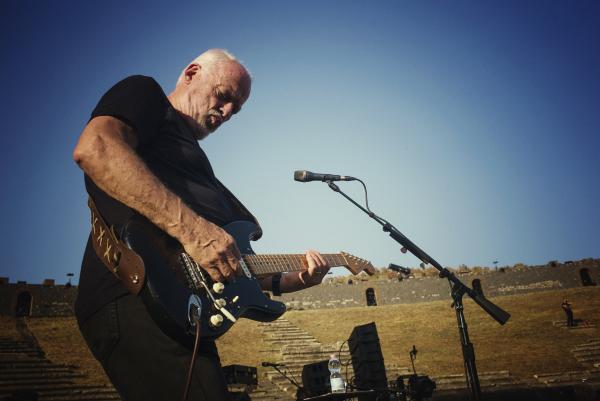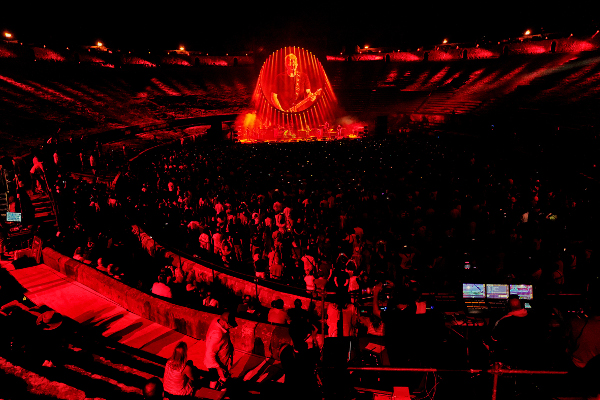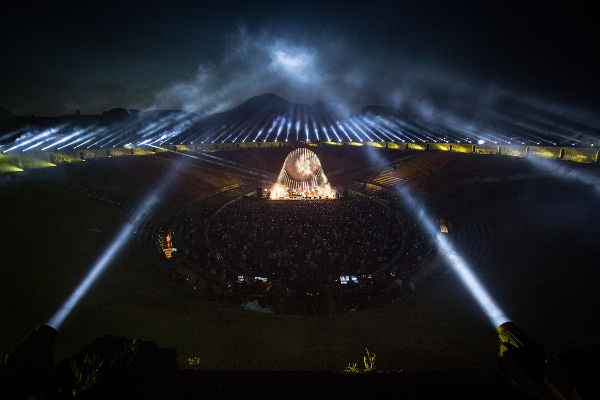Too bad Roger and Nic are not involved..
Gavin Elder on Filming David Gilmour’s Live Return to Pompeii

In David Gilmour’s stunning new Live at Pompeii Blu-ray, following a stirring rendition of “The Great Gig in the Sky” — the seminal, haunting instrumental track written by the late keyboardist Rick Wright that ends Side 1 of 1973’s The Dark Side of the Moon — the guitarist/vocalist pauses to observe, “Ghosts from the past, and from the recent past, and the distant past are with us here tonight.”
And how right he is. Without a doubt, the Pompeii performances were a major highlight of the world tour Gilmour undertook in support of his 2015 solo album Rattle That Lock. In fact, the guitarist/vocalist’s July 7 and 8, 2016 concerts at that storied Pompeii ampitheatre marked the first time anyone had performed there in front of a live audience since the gladiators put on their own special brand of swords & sandals entertainment waaaaaay back in 79 A.D. And when Mount Vesuvius erupted the day after the local Vulcanalia festival celebration and buried the city for centuries, the rest, as the saying goes, is history.
Speaking of historical trajectory, this pair of 2016 shows took place 45 years after Gilmour had played the same ampitheatre with Pink Floyd in 1971 for the magical Pink Floyd Live at Pompeii film directed with of-era charm and panache by Adrian Maben. The only “audience” in attendance back then, as viewers will recall, was Maben and his skeleton camera crew. (Incidentally, you can visit/revisit this special gig on standalone DVD, on Blu-ray as part of last year’s The Early Years: 1965 – 1972 box set, or on CD as part of the band’s three-disc 1972 Obfusc/ation collection.)
And now, Gilmour’s 2016 performances have just been released in various formats as Live at Pompeii (Columbia), including a four-disc box set featuring two in-stereo CDs of the 2½-hour-long set, one Blu-ray of the concert in hi-res surround sound and the Pompeii Then and Now documentary, and an additional Blu-ray with a wealth of additional live performances and related documentary material.
Helming the visuals for Live at Pompeii was longtime Gilmour visual compatriot Gavin Elder, who also lensed live events and their subsequent releases for the likes of AC/DC, Robbie Williams, and Duran Duran. Elder and I recently got on the line to discuss the logistics of filming in such a historic locale, the goals for the concert’s color palette, and how his team figured out a way to accommodate Gilmour’s lone specific visual wish for the production. They may not have traded our heroes for ghosts, but Elder and Gilmour sure made us wish we were there.
Mike Mettler: Did you feel the weight of history while you were filming in the ampitheatre in Pompeii? That’s a pretty heavy location, to put it mildly.
Gavin Elder: Very much so. It hadn’t been used for a very long time (chuckles), so that certainly added to the spectacular nature of the evening, if you like. That, and the fact that the last time there’d been an audience there was almost 2,000 years before, right before the volcanic eruption.
I had been to the regular location a few times to plot and scout camera locations, so for me, perhaps it didn’t have as much significance as it did for David, considering he had been there for the 1971 show with the rest of Pink Floyd — and the fact that Richard [Wright] is no longer around. David said he felt like he could understand there were ghosts there. [Wright, who played many a keyboard at the original Floyd Pompeii performance, died in 2008 in London at age 65.]
Mettler: Right — during the show, right after playing “The Great Gig in the Sky,” David made reference to ghosts of the past and recent past being there with everyone.
Elder: Yeah, he did. He was so eloquent. He put it so well. We just really tried to capture the majesty of the evening. It was the middle of summer on these beautiful, hot evenings. It was the most special concert I think I’ve ever attended, and also had the good fortune of playing a part in.
Mettler: Did you watch or consult the 1971 Pink Floyd Live at Pompeii film, just to get a sense of what the Pompeii location was all about?
Elder: I had watched it just as a Pink Floyd fan years and years ago, and I revisited it before filming David there. What I really enjoy about that film is the pace. It’s very slow, and deliberate. In that slowness, you just settle into the pace. I think a lot of films are overcut these days.
Mettler: I agree. There were a lot of great sequences in the original, like where you’re just watching Nick Mason drum for extended periods of time. I rewatched it on Blu-ray when Pink Floyd’s The Early Years box set came out last year, and I remember thinking, “This is what I prefer to see, as a fan of the artist.” I’d rather see Nick, David, Rick, and Roger [Waters] all play for extended periods of time, rather than having the camera jump away from them too quickly.
Elder: Yeah, yeah. I was chatting with Adrian Maben, the director, who was in Pompeii at the time we were filming David, because he was having a photographic exhibition there [showing original footage, interviews, outtakes, and memorabilia related to the original film]. It was just a coincidence; we had no idea he was going to be there at that time. But it added another level of detail for the fans who were there, because they were able to go and see and reference that earlier show.
Adrian was at the premiere with us in London [on September 5]. He’s a lovely man. He came up to me after the screening and said he really enjoyed it. It was very different. He was saying when he shot Pompeii in ’71, they had three cameras. Whereas we had shot over 2 nights with probably 17 or 18 cameras per night.
He also said he felt it complemented his film perfectly, and that was a lovely compliment to receive: “The two make a good set.”

Mettler: It is a good then-and-now bookend kind of thing, that’s true. And the only track that overlaps between the two films is “One of These Days” [from Pink Floyd’s 1971 release, Meddle]. I think that was the right call, because David had said he didn’t feel comfortable doing “Echoes” [the 23-minute epic that comprises all of Side 2 of Meddle] without Rick there, and I hope people understand why it had to be done that way.
Elder: Yeah, exactly. “Echoes” is a musical dialogue between David and Rick. And if only one of them is there, it doesn’t work as a monologue. The Live in Gdańsk version of “Echoes” is the right one for that, I think. [Live in Gdańsk chronicles the final show of Gilmour’s On An Island Tour, recorded live on August 26, 2006 at the Gdańsk Shipyard in Poland, and it was later released in various formats in 2008.]
Mettler: Ah, you read my mind about that performance! (both chuckle) I was honored to attend David’s show at Radio City [Music Hall in New York City on April 4, 2006], so I got to see both he and Rick do “Echoes” live together. It was such a magical thing, because I never thought I’d ever see them do it live. But it’s also nice to have the Gdańsk version, that’s for sure.
Elder: You’ve seen it live, so you’ve seen there’s an intuitiveness there. Each of them know where the other one is going to go, after years of playing together. And nobody else could do that song justice, I don’t think. It’s had its time.
Mettler: I totally agree with that. You’ve been behind the lens for a number of David’s most significant performances, and it sounds and looks to me that you have the instinctive eye in terms of knowing exactly what shots to get and where the cuts should be. Rather than following that jump-cut style, you let the players play, and you pull back to where we can even see things like the flame going at the back of the stadium. Wait — can I even call it a stadium? That’s not the right name for it, is it? (both laugh)
Elder: Amiptheatre is the proper term. In the olden days, it was called a spectacula, or Spectaculum. It was the Roman [Latin] word for theater, or a place of spectacle — and it’s a lovely word for it.
I was chatting with Guy Pratt, the bass player, about this just the other day — about how we didn’t want to make the film just about David, because it’s a band, and he’s the leader of it. He’s the reason we’re there, but having the other members in relation to him there onstage is a very important thing — to keep the sense of the musicality of the film.
Mettler: I think a good example of that is in “Shine on You Crazy Diamond,” where we see Chuck Leavell do his special parts, and the camera goes behind him so we can see him do his thing on the keyboard from another angle. And then we see Greg [Phillinganes] singing his key parts and lead vocals during “Time.” Like you said, we needed to get a fair representation of the whole band doing what it does up there.
Elder: Yeah, yeah. That was a great thing to do.
Mettler: One of the other things I like is that whenever you show Stevie D [DiStanislao] drumming, he’s never not smiling. He’s one of the most inviting, joyful drummers I’ve ever seen. I’ve seen him tour with Don Felder and Crosby, Stills & Nash, and he does that no matter who he’s playing with.
Elder: Stevie injects so much energy and joy and happiness and love into the performance, if you like. And he’s clearly having an amazing time! He lives off of that — performing live. To be able to film a drummer like him really adds to the show.
I saw him before the London screening and I said, “Look, I’m sure you’re gonna love it, because I think you look great — and you get a lot of exposure in the film, and a lot of screen time.” He came up to me after and said, “Oh, I just love it! I love it!” (chuckles heartily)
Mettler: I love the shots framed behind Stevie where you can see Guy on one side and then the spotlight shining down on David at centerstage. Your directorial eye makes sure we get to see what everybody does up there. And because the show unfolds over the course of 2½ hours, we get to see the personality of each player.
Elder: I hadn’t thought of that, but yeah, you’re right. You can see the more mischievous players too — the ones who are moving, and jumping up and down.
Mettler: I also like how you focus on the hand movements and physical reactions of all the singers.
Elder: There are three fantastic singers who all really let loose on “Great Gig” [Bryan Chambers, Lucita Jules, and Louise Clare Marshall]. They really put together a wonderful arrangement. Again, they’re just grooving the whole way through the show, and that just helps keep the energy level up — and the visual energy up as well. When we were cutting it, we were very pleased to have that element onstage so that whenever we needed to, we could inject that element of “cool passion,” for emphasis.
Mettler: That’s not a bad thing to have. Maybe “cool passion” should even the name of your next project. (Elder laughs) And is that dry ice or smoke that I see billowing a lot of times across the stage?
Elder: It wasn’t dry ice, no, but it was smoke machines. [Lighting director] Marc Brickman has worked with David since [1979’s] The Wall and the early ’80s, and he’s an integral part of the show. His lighting was an interesting thing for us to deal with, because cameras require a little bit more than the naked eye, and we had many discussions with him as to how we could find this balance. We finally compromised without going too much in either direction. We didn’t want it to be overlit, and we didn’t want it to be too dark.
But the songs where there is a little bit of darkness and there’s a lot of mood, and a lot of David’s silhouette — those are most successful when Marc’s lighting is really at its best.

Mettler: And you shot it in 4K, so detail is critical. David is wearing dark clothing — the black t-shirt and pants, and he’s playing a black guitar — and I like seeing things like the folds in his shirt as he moves and where some of the finish on his black guitar has worn off. Sometimes that’s as interesting to me as the quality of the high-def soundtrack. Would you say going the 4K route helped in terms of capturing things like that?
Elder: Oh, definitely. As we were editing it, we were referencing back to HD. That is, we were cutting in HD, and we finished in 4K. We always knew we would have that extra amount of definition to work with, and we would be able to saturate the colors more and manipulate the image more because we could have so much more detail.
The whole way through, the chap in charge of the coloring and the finishing, James Tonkin, spent months and months finessing it. We had some quite tricky conditions, with the low lighting and some of the smoke levels as well, which obviously adds so much more information to a picture.
Mettler: We also got a lot of those cool aerial shots from outside the ampitheatre. How did you get those set up?
Elder: Some of them were from a camera that was actually positioned on top of the amphitheatre wall. But the one thing David had said — and it was probably the only direction he really had — was that he wanted a drone. So we put in that request really early on with the Italian authorities, and they said, “No. Absolutely not. You’re not flying a drone over this great monument of art.” We obviously couldn’t report that back to David (both chuckle), so we just kept on. His production people and the producer of the film just kept on asking. I think they [i.e., the Italian authorities] just wanted to be assured that people knew what they were doing, and once they had that reassurance, they were fine with it.
So, we got the drones. And without them, we would have lost the chance of getting the full scale of the place.
Mettler: Agreed. Even after watching the ’71 film, as majestic and grand as the interior location is, you’re still not getting the full context of the scope of the overall location itself.
Elder: You’re right. And they just didn’t have the physical structure to get up to do that top shot looking down.
Mettler: With only having three cameras at their disposal, it was basically “get what you can get.”
Elder: Exactly. And that was the thing I was saying to Adrian [Mabel] — his film was done 45 years ago, and we can look at the technological differences and options available to us now. In another 45 years’ time, how will audiences perceive a rock & roll show?
Mettler: That’s a good point. I suppose the attention span of those future audiences will dictate that to some degree. Could you pick out a personal favorite visual moment in the film? The one where you went, “OK, we got this exactly how I envisioned it”?
Elder: For me, it’s one of the slowest songs, the one that’s called “A Boat Lies Waiting.”
Mettler: Right, the Rattle That Lock track that’s David’s tribute to Rick Wright.
Elder: Yes, it is. It’s so gentle and fragile, and the lighting and camera moves really reflect and enhance it. And, of course, I also like the big, bombastic moments of “Run Like Hell.” Fireworks are always fun. (both laugh)
Mettler: Sure are! Did you put shades [i.e., sunglasses] on like everybody else did?
Elder: (laughs heartily) I was in a refrigerated box at the back, so, no. Yeah, it was incredibly dull. (chuckles) I didn’t get to see it out in front. I had seen all the camera checks the nights before, but on the nights of shooting, I was locked into looking at things from a multiple screen perspective — which was very exciting as well, because I got to see everything from there.
When we had the screening of the film in the cinema in London, the whole band was there and David was there, and it was a really lovely evening. It brought that memory back from last July [in 2016], and we sort of relived it all over again. What a magical time it was.
- Log in or register to post comments

























































